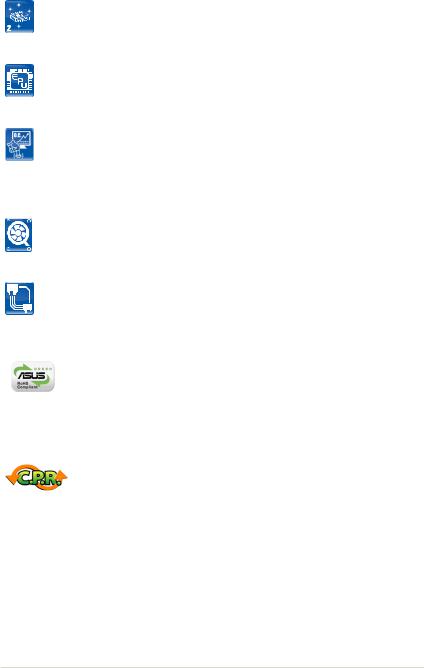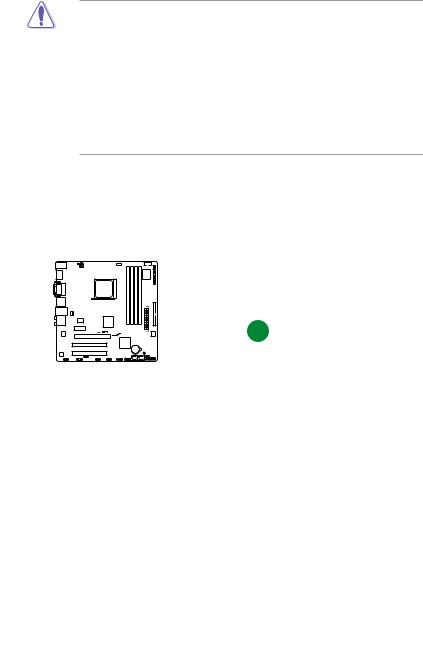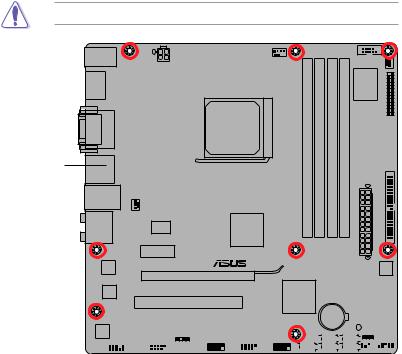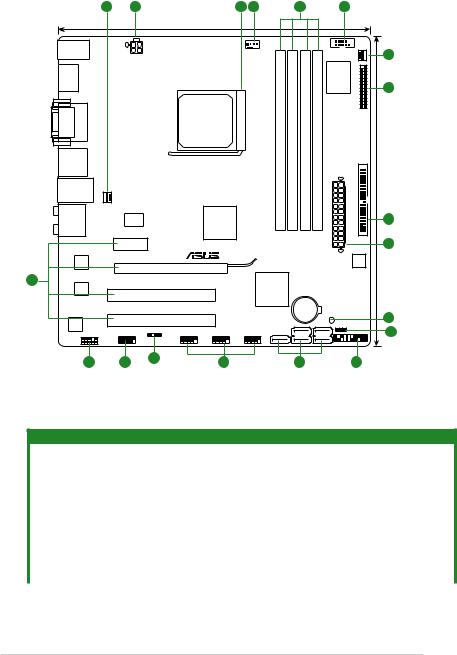ASUS M4A785TD-M EVO User Manual

M4A785TD-M EVO
Motherboard

E4840
First Edition V1
July 2009
Copyright © 2009 ASUSTeK Computer Inc. All Rights Reserved.
No part of this manual, including the products and software described in it, may be reproduced, transmitted, transcribed, stored in a retrieval system, or translated into any language in any form or by any means, except documentation kept by the purchaser for backup purposes, without the express written permission of ASUSTeK Computer Inc. (“ASUS”).
Product warranty or service will not be extended if: (1) the product is repaired, modified or altered, unless such repair, modification of alteration is authorized in writing by ASUS; or (2) the serial number of the product is defaced or missing.
ASUS PROVIDES THIS MANUAL “AS IS” WITHOUT WARRANTY OF ANY KIND, EITHER EXPRESS OR IMPLIED, INCLUDING BUT NOT LIMITED TO THE IMPLIED WARRANTIES OR CONDITIONS OF MERCHANTABILITY OR FITNESS FOR A PARTICULAR PURPOSE. IN NO EVENT SHALL ASUS, ITS DIRECTORS, OFFICERS, EMPLOYEES OR AGENTS BE LIABLE FOR ANY INDIRECT, SPECIAL, INCIDENTAL, OR CONSEQUENTIAL DAMAGES (INCLUDING DAMAGES FOR LOSS OF PROFITS, LOSS OF BUSINESS, LOSS OF USE OR DATA, INTERRUPTION OF BUSINESS AND THE LIKE), EVEN IF ASUS HAS BEEN ADVISED OF THE POSSIBILITY OF SUCH DAMAGES ARISING FROM ANY DEFECT OR ERROR IN THIS MANUAL OR PRODUCT.
SPECIFICATIONS AND INFORMATION CONTAINED IN THIS MANUAL ARE FURNISHED FOR INFORMATIONAL USE ONLY, AND ARE SUBJECT TO CHANGE AT ANY TIME WITHOUT NOTICE, AND SHOULD NOT BE CONSTRUED AS A COMMITMENT BY ASUS. ASUS ASSUMES NO RESPONSIBILITY OR LIABILITY FOR ANY ERRORS OR INACCURACIES THAT MAY APPEAR IN THIS MANUAL, INCLUDING THE PRODUCTS AND SOFTWARE DESCRIBED IN IT.
Products and corporate names appearing in this manual may or may not be registered trademarks or copyrights of their respective companies, and are used only for identification or explanation and to the owners’ benefit, without intent to infringe.
ii

Contents
Notices......................................................................................................... |
vi |
Safety information...................................................................................... |
vii |
About this guide........................................................................................ |
viii |
M4A785TD-M EVO specifications summary.............................................. |
x |
Chapter 1: Product introduction
1.1 |
Welcome!....................................................................................... |
1-1 |
|
1.2 |
Package contents......................................................................... |
1-1 |
|
1.3 |
Special features............................................................................ |
1-1 |
|
|
1.3.1 |
Product highlights ............................................................ |
1-1 |
|
1.3.2 |
Innovative ASUS features ................................................ |
1-4 |
1.4 |
Before you proceed...................................................................... |
1-6 |
|
1.5 |
Motherboard overview................................................................. |
1-7 |
|
|
1.5.1 |
Placement direction ......................................................... |
1-7 |
|
1.5.2 |
Screw holes ..................................................................... |
1-7 |
|
1.5.3 |
Motherboard layout .......................................................... |
1-8 |
|
1.5.4 |
Layout contents . .............................................................. |
1-8 |
1.6 |
Central Processing Unit (CPU).................................................... |
1-9 |
|
|
1.6.1 |
Installing the CPU ............................................................ |
1-9 |
|
1.6.2 |
Installing the heatsink and fan ........................................ |
1-11 |
1.7 |
System memory.......................................................................... |
1-12 |
|
|
1.7.1 |
Overview ........................................................................ |
1-12 |
|
1.7.2 |
Memory configurations . ................................................. |
1-13 |
|
1.7.3 |
Installing a DIMM ........................................................... |
1-17 |
|
1.7.4 |
Removing a DIMM ......................................................... |
1-17 |
1.8 |
Expansion slots.......................................................................... |
1-18 |
|
|
1.8.1 |
Installing an expansion card .......................................... |
1-18 |
|
1.8.2 |
Configuring an expansion card ...................................... |
1-18 |
|
1.8.3 |
PCI slots . ....................................................................... |
1-18 |
|
1.8.4 |
PCI Express x1 slot . ...................................................... |
1-18 |
|
1.8.5 |
PCI Express x16 slot . .................................................... |
1-18 |
1.9 |
Jumpers |
....................................................................................... |
1-19 |
1.10 |
Connectors.................................................................................. |
1-20 |
|
|
1.10.1 ............................................................ |
Rear panel ports |
1-20 |
|
1.10.2 ........................................................ |
Internal connectors |
1-23 |
iii

Contents
1.11 Software support........................................................................ |
1-30 |
|
1.11.1 |
Installing an operating system....................................... |
1-30 |
1.11.2 |
Support DVD information............................................... |
1-30 |
Chapter 2: BIOS information
2.1 |
Managing and updating your BIOS............................................. |
2-1 |
|
|
2.1.1 |
ASUS Update utility......................................................... |
2-1 |
|
2.1.2 |
ASUS EZ Flash 2 utility................................................... |
2-3 |
|
2.1.3 |
ASUS CrashFree BIOS 3 utility....................................... |
2-4 |
2.2 |
BIOS setup program..................................................................... |
2-5 |
|
|
2.2.1 |
BIOS menu screen.......................................................... |
2-6 |
|
2.2.2 |
Menu bar......................................................................... |
2-6 |
|
2.2.3 |
Navigation keys............................................................... |
2-6 |
|
2.2.4 |
Menu items...................................................................... |
2-7 |
|
2.2.5 |
Submenu items................................................................ |
2-7 |
|
2.2.6 |
Configuration fields.......................................................... |
2-7 |
|
2.2.7 |
Pop-up window................................................................ |
2-7 |
|
2.2.8 |
Scroll bar......................................................................... |
2-7 |
|
2.2.9 |
General help.................................................................... |
2-7 |
2.3 |
Main menu..................................................................................... |
2-8 |
|
|
2.3.1 |
System Time.................................................................... |
2-8 |
|
2.3.2 |
System Date.................................................................... |
2-8 |
|
2.3.3 |
Primary IDE Master/Slave, SATA 1/2/3/5/6, E-SATA....... |
2-8 |
|
2.3.4 |
SATA Configuration.......................................................... |
2-9 |
|
2.3.5 |
System Information.......................................................... |
2-9 |
2.4 |
Advanced menu.......................................................................... |
2-10 |
|
|
2.4.1 |
JumperFree Configuration............................................. |
2-10 |
|
2.4.2 |
CPU Configuration......................................................... |
2-12 |
|
2.4.3 |
Chipset.......................................................................... |
2-13 |
|
2.4.4 |
Onboard Device Configuration...................................... |
2-14 |
|
2.4.5 |
PCIPnP.......................................................................... |
2-15 |
|
2.4.6 |
USB Configuration......................................................... |
2-15 |
iv

Contents
2.5 |
Power menu................................................................................ |
2-16 |
|
|
2.5.1 |
Suspend Mode.............................................................. |
2-16 |
|
2.5.2 |
ACPI 2.0 Support........................................................... |
2-16 |
|
2.5.3 |
ACPI APIC Support....................................................... |
2-16 |
|
2.5.4 |
APM Configuration........................................................ |
2-17 |
|
2.5.5 |
HW Monitor Configuration............................................. |
2-17 |
2.6 |
Boot menu................................................................................... |
2-18 |
|
|
2.6.1 |
Boot Device Priority....................................................... |
2-18 |
|
2.6.2 |
Boot Settings Configuration........................................... |
2-18 |
|
2.6.3 |
Security.......................................................................... |
2-19 |
2.7 |
Tools menu.................................................................................. |
2-20 |
|
|
2.7.1 |
ASUS EZ Flash 2.......................................................... |
2-20 |
|
2.7.2 |
Express Gate................................................................. |
2-21 |
|
2.7.3 |
AI NET 2........................................................................ |
2-21 |
2.8 |
Exit menu..................................................................................... |
2-22 |
|

Notices
Federal Communications Commission Statement
This device complies with Part 15 of the FCC Rules. Operation is subject to the following two conditions:
•This device may not cause harmful interference, and
•This device must accept any interference received including interference that may cause undesired operation.
This equipment has been tested and found to comply with the limits for a Class B digital device, pursuant to Part 15 of the FCC Rules. These limits are designed to provide reasonable protection against harmful interference in a residential installation. This equipment generates, uses and can radiate radio frequency energy and, if not installed and used in accordance with manufacturer’s instructions, may cause harmful interference to radio communications. However, there is no guarantee that interference will not occur in a particular installation. If this equipment does cause harmful interference to radio or
television reception, which can be determined by turning the equipment off and on, the user is encouraged to try to correct the interference by one or more of the following measures:
•Reorient or relocate the receiving antenna.
•Increase the separation between the equipment and receiver.
•Connect the equipment to an outlet on a circuit different from that to which the receiver is connected.
•Consult the dealer or an experienced radio/TV technician for help.
The use of shielded cables for connection of the monitor to the graphics card is required to assure compliance with FCC regulations. Changes or modifications to this unit not expressly approved by the party responsible for compliance could void the user’s authority to operate this equipment.
Canadian Department of Communications Statement
This digital apparatus does not exceed the Class B limits for radio noise emissions from digital apparatus set out in the Radio Interference Regulations of the Canadian Department of Communications.
This class B digital apparatus complies with Canadian ICES-003.
REACH
Complying with the REACH (Registration, Evaluation, Authorisation, and Restriction of Chemicals) regulatory framework, we published the chemical substances in our products at ASUS REACH website at http://green.asus.com/english/REACH.htm.
DO NOT throw the motherboard in municipal waste. This product has been designed to enable proper reuse of parts and recycling. This symbol of the crossed out wheeled bin indicates that the product (electrical and electronic equipment) should not be placed in municipal waste. Check local regulations for disposal of electronic products.
DO NOT throw the mercury-containing button cell battery in municipal waste. This symbol of the crossed out wheeled bin indicates that the battery should not be placed in municipal waste.
vi

Safety information
Electrical safety
•To prevent electric shock hazard, disconnect the power cable from the electric outlet before relocating the system.
•When adding or removing devices to or from the system, ensure that the power cables for the devices are unplugged before the signal cables are connected. If possible, disconnect all power cables from the existing system before you add a device.
•Before connecting or removing signal cables from the motherboard, ensure that all power cables are unplugged.
•Seek professional assistance before using an adapter or extension cord. These devices could interrupt the grounding circuit.
•Ensure that your power supply is set to the correct voltage in your area. If you are not sure about the voltage of the electrical outlet you are using, contact your local power company.
•If the power supply is broken, do not try to fix it by yourself. Contact a qualified service technician or your retailer.
•The optical S/PDIF is an optional component (may or may not be included in your motherboard) and is defined as a CLASS 1 LASER PRODUCT.
INVISIBLE LASER RADIATION, AVOID EXPOSURE TO BEAM.
•Never dispose of the battery in fire. It could explode and release harmful substances into the environment.
•Never dispose of the battery with your regular household waste. Take it to a hazardous material collection point.
•Never replace the battery with an incorrect battery type.
• RISK OF EXPLOSION IF BATTERY IS REPLACED BY AN INCORRECT TYPE.
•DISPOSE OF USED BATTERIES ACCORDING TO THE ABOVE BATTERY-RELATED INSTRUCTIONS.
vii

Operation safety
•Before installing the motherboard and adding devices on it, carefully read all the manuals that came with the package.
•Before using the product, ensure that all cables are correctly connected and the power cables are not damaged. If you detect any damage, contact your dealer immediately.
•To avoid short circuits, keep paper clips, screws, and staples away from connectors, slots, sockets and circuitry.
•Avoid dust, humidity, and temperature extremes. Do not place the product in any area where it may become wet.
This motherboard should only be used in environments with ambient temperatures between 5ºC (41ºF) and 40ºC (104ºF).
•Place the product on a stable surface.
•If you encounter technical problems with the product, contact a qualified service technician or your retailer.
About this guide
This user guide contains the information you need when installing and configuring the motherboard.
How this guide is organized
This guide contains the following parts:
•Chapter 1: Product introduction
This chapter describes the features of the motherboard and the new technology it supports.
•Chapter 2: BIOS information
This chapter tells how to change system settings through the BIOS Setup menus. Detailed descriptions of the BIOS parameters are also provided.
viii

Conventions used in this guide
To ensure that you perform certain tasks properly, take note of the following symbols used throughout this manual.
DANGER/WARNING: Information to prevent injury to yourself when trying to complete a task.
CAUTION: Information to prevent damage to the components when trying to complete a task.
IMPORTANT: Instructions that you MUST follow to complete a task.
NOTE: Tips and additional information to help you complete a task.
Where to find more information
Refer to the following sources for additional information and for product and software updates.
1.ASUS websites
The ASUS website provides updated information on ASUS hardware and software products. Refer to the ASUS contact information.
2.Optional documentation
Your product package may include optional documentation, such as warranty flyers, that may have been added by your dealer. These documents are not part of the standard package.
Typography
Bold text |
Indicates a menu or an item to select. |
Italics |
Used to emphasize a word or a phrase. |
<Key> |
Keys enclosed in the less-than and greater-than sign means |
|
that you must press the enclosed key. |
|
Example: <Enter> means that you must press the Enter or |
|
Return key. |
<Key1>+<Key2>+<Key3> |
If you must press two or more keys simultaneously, the key |
|
names are linked with a plus sign (+). |
|
Example: <Ctrl>+<Alt>+<D> |
ix

M4A785TD-M EVO specifications summary
CPU
Chipset
Front side bus
Memory
Graphics
Expansion slots
AMD® Socket AM3 for AMD® Phenom™ II / Athlon™ II /
Sempron™ 100 series processors Supports 45nm CPU
AMD® Cool ‘n’ Quiet™ Technology
* Refer to www.asus.com for the AMD® CPU support list
AMD® 785G / SB710
Up to 5200MT/s HyperTransport™ 3.0 interface
Dual-channel memory architecture
4 x 240-pin DIMM slots support maximum 16GB unbuffered ECC and non-ECC DDR3 1800(O.C.)/1600(O.C.)/1333/ 1066MHz memory modules
*Refer to www.asus.com for the latest Memory QVL
(Qualified Vendors List).
**When you install a total memory of 4GB or more, Windows® 32-bit operating system may only recognize less than 3GB. We recommend a maximum of 3GB system memory if you are using a Windows® 32-bit operating system.
Integrated ATI Radeon™ HD 4200 GPU
Supports SidePort Memory – onboard 128MB DDR3 1333 memory
Supports HDMI™ with max. resolution up to
1920x1200 (1080P)
Supports Dual Link DVI-D with max. resolution up to
2560x1600@60Hz
Supports RGB with max. resolution up to 2560x1440@75Hz
Supports Hybrid CrossFireX™ (for Windows® Vista only) Dual VGA output supports:
–RGB & DVI
–RGB & HDMI
Supports Microsoft® DirectX 10.1, OpenGL 2.0, and
Shader Model 4.1
Hardware Decode Acceleration for H.264, VC-1, and MPEG-2
Maximum shared memory up to 512MB
* Refer to www.amd.com for the discrete GPUs which support Hybrid CrossFireX™.
1 x PCIe 2.0 x16 slot
1 x PCIe x1 slot
2 x PCI slots
(continued on the next page)

M4A785TD-M EVO specifications summary
Storage / RAID
Audio
IEEE 1394
USB
LAN
ASUS special features
ASUS overclocking features
Other features
AMD® SB710 southbridge:
–1 x Ultra DMA 133/100/66 connector for up to 2 PATA devices
–5 x Serial ATA 3Gb/s connectors support RAID 0, RAID 1, and RAID 0+1 configurations
–1 x eSATA 3Gb/s port
VIA® VT1708S 8-channel High Definition Audio CODEC
Supports Jack-detect, Multi-streaming, and Front Panel Retasking
Supports S/PDIF_OUT interface
JMB381 controller supports 2 IEEE 1394a ports
(one at mid-board, the other at the back panel)
Supports up to 12 USB 2.0/1.1 ports (6 ports at mid-board,
6 ports at the back panel)
RTL8112L PCIe Gigabit LAN controller featuring AI NET2
ASUS Q-Fan
ASUS CrashFree BIOS3
ASUS EZ Flash2
ASUS MyLogo2
ASUS Express Gate
ASUS AI NET2
ASUS EPU-4 Engine
ASUS Turbo Key
ASUS GPU NOS
SFS (Stepless Frequency Selection) supports:
–HT tuning from 200MHz to 550MHz at 1MHz increment
–PCIe frequency tuning from 100MHz to 150MHz at 1MHz increment
ASUS C.P.R. (CPU Parameter Recall)
100% All High-quality Conductive Polymer Capacitors AMD® OverDrive
* An advanced cooling system is required when the advanced overclocking functions of AMD® OverDrive are enabled.
(continued on the next page)
xi

M4A785TD-M EVO specifications summary
Back panel I/O ports
Internal I/O connectors
BIOS
Manageability
Accessories
Form factor
Support DVD
1 x PS/2 Keyboard / Mouse Combo port
1 x RJ-45 port
1 x VGA port
1 x DVI-D port
1 x eSATA port
1 x HDMI port
1 x IEEE 1394a port
1 x Optical S/PDIF_OUT port
6 x USB 2.0/1.1 ports
8-channel audio ports
3 x USB 2.0/1.1 connectors support additional
6 USB 2.0/1.1 ports
1 x IDE connector
1 x COM connector
1 x LPT connector
5 x SATA connectors
1 x High definition front panel audio connector
1 x System panel connector
1 x S/PDIF_OUT connector
1 x IEEE 1394a connector
1 x CPU / 1 x Power / 1 x Chassis fan connectors 1 x 24-pin EATX power connector
1 x 4-pin ATX 12V power connector
8Mb Flash ROM, AMI BIOS, PnP, DMI2.0, WfM2.0, ACPI2.0a, SM BIOS 2.5
WOL by PME, WOR by PME, WOR by Ring, PXE
2 x Serial ATA cables
1 x Ultra DMA 133/100/66 cable
1 x I/O shield
1 x User Manual
MicroATX form factor: 9.6 in x 9.6 in (24.4 cm x 24.4 cm)
Drivers
ASUS Update
ASUS PC Probe II
AMD® OverDrive (AOD)
Anti-Virus software (OEM version)
* Specifications are subject to change without notice.
xii

Chapter 1
Product introduction
1.1Welcome!
Thank you for buying an ASUS® M4A785TD-M EVO motherboard!
The motherboard delivers a host of new features and latest technologies, making it another standout in the long line of ASUS quality motherboards!
Before you start installing the motherboard, and hardware devices on it, check the items in your package with the list below.
1.2Package contents
Check your motherboard package for the following items.
Motherboard |
ASUS M4A785TD-M EVO motherboard |
Cables |
2 x Serial ATA cables |
|
1 x Ultra DMA 133/100/66 cable |
Accessories |
1 x I/O shield |
Application DVD |
ASUS motherboard Support DVD |
Documentations |
User Manual |
If any of the above items is damaged or missing, contact your retailer.
1.3Special features
1.3.1Product highlights
AMD® Phenom™ II / Athlon™ II / Sempron™ 100 series CPU support
This motherboard supports AMD® Socket AM3 multi-core processors with unique L3 cache and delivers better overclocking capabilities with less power consumption. It features dual-channel DDR3 1333 memory support and accelerates data transfer rate up to 5200MT/s via
HyperTransport™ 3.0-based system bus. This motherboard also supports AMD® CPUs in the new 45nm manufacturing process.
ASUS M4A785TD-M EVO |
1-1 |

5200
MT/s
AMD® 785G Chipset
The AMD® 785G Chipset is designed to support up to 5200MT/s HyperTransport™ 3.0 (HT 3.0) interface speed and PCI Express 2.0 x16 graphics. It is optimized with AMD’s latest AM3 multi-core CPUs to provide excellent system performance and overclocking capabilities.
HyperTransport™ 3.0 support
HyperTransport™ 3.0 technology provides 2.6 times more bandwidth than HT1.0 that radically improves system efficiency for a smoother and faster computing environment.
AMD Cool ‘n’ Quiet Technology
This motherboard supports the AMD Cool ‘n’ Quiet technology which monitors system operation and automatically adjusts CPU voltage and frequency for a cool and quiet operating environment.
DDR3 1800(O.C.) support
This motherboard supports DDR3 1800(O.C.)/1600(O.C.)/1333/ 1066MHz memory that features faster data transfer rates and more bandwidth to meet the requirements of the latest operation system, 3D graphics, multimedia, and Internet applications. The dual-channel DDR3 architecture doubles the bandwidth of your system memory to boost system performance, eliminating bottlenecks with peak bandwidth up to
25.6GB/s. Furthermore, the supply voltage for the memory is reduced from 1.8V for DDR2 to just 1.5V for DDR3. This voltage reduction limits the power consumption and heat generation of DDR3, which makes it an ideal memory solution.
PCI Express 2.0 support
This motherboard supports PCI Express 2.0 devices for double speed and bandwidth which enhances system performance.
SidePort Memory
This motherboard features SidePort Memory, an individual onboard DDR3 memory serving as memory buffer for integrated graphics. With low CPU usage, the SidePort Memory provides integrated graphics acceleration and effectively boosts graphics performance.
1-2 |
Chapter 1: Product introduction |

Hybrid CrossFireX™ support
ATI Hybrid CrossFireX™ technology greatly boosts graphics performance with an onboard GPU and a discrete graphics GPU.
• Hybrid CrossFireX™ is supported by Windows® Vista OS only.
• Refer to www.amd.com for the discrete GPUs which support Hybrid CrossFireX™.
Serial ATA 3Gb/s technology and SATA-On-The-Go
This motherboard supports hard drives based on the Serial ATA (SATA)
3Gb/s storage specification, delivering enhanced scalability and doubling the bus bandwidth for high-speed data retrieval and save. The external SATA port provides smart setup and hot-plug functions for easy data backup to external devices.
8-channel high definition audio
The onboard 8-channel HD audio (High Definition Audio, previously codenamed Azalia) CODEC enables high-quality 192KHz/24-bit audio output and jack-detect feature that automatically detects and identifies what types of peripherals are plugged into the audio I/O jacks and notifies users of inappropriate connection, which means there will be no more confusion of Line-in, Line-out, and Mic jacks.
HDMI support
HDMI (High-Definition Multimedia Interface) is a set of digital video standards that deliver multi-channel digital audio and uncompressed digital video for full HD 1080p visuals through a single cable. Supporting HDCP copy protection such as HD DVD and Blu-ray discs, HDMI provides you with the highest-quality home theater experience.
Dual VGA output
This motherboard supports dual display output on digital HDMI/DVI and analog D-Sub. DVI (Digital Visual Interface) provides high quality visuals for digital display devices like LCD monitors.
IEEE 1394a support
The IEEE 1394a interface provides high-speed connectivity for digital audio/video devices, digital video camcorders, PCs, and storage peripherals.
ASUS M4A785TD-M EVO |
1-3 |

S/PDIF digital sound ready
This motherboard provides convenient connectivity to external home theater audio systems via coaxial and optical S/PDIF_OUT (SONYPHILIPS Digital Interface) jacks. The S/PDIF transfers digital audio without converting it to analog format and keeps the best signal quality.
1.3.2Innovative ASUS features
ASUS MyLogo2™
Turn your favorite photos into 256-color boot logos to personalize your system.
ASUS Express Gate
ASUS Express Gate is an instant-on environment that gives you quick access to the Internet. Five seconds after powering on your computer, you can instantly surf the Internet without entering the Windows® OS.
• ASUS Express Gate supports installation on SATA HDDs, USB HDDs and flash drives with at least 1.2GB free disk space. When installing it on USB HDDs or flash drives, connect the drives to the motherboard USB port before turning on the computer.
•The actual boot time depends on the system configuration.
•ASUS Express Gate supports file uploading from SATA HDDs, ODDs and USB drives. It supports file downloading to USB drives only.
•ASUS Express Gate complies with the OpenGL standard. Refer to support.asus.com for Express Gate source codes.
ASUS GPU NOS
ASUS GPU NOS technology intelligently detects graphics loading and automatically boosts performance for the most demanding tasks. It provides you with a faster reaction time for an excellent graphics performance.
ASUS CrashFree BIOS 3
ASUS CrashFree BIOS 3 is an auto-recovery tool that allows you to restore a corrupted BIOS file using the bundled support DVD or a USB flash disk that contains the BIOS file.
1-4 |
Chapter 1: Product introduction |

ASUS EZ Flash 2
ASUS EZ Flash 2 allows you to update the BIOS from a USB flash disk before entering the OS.
ASUS EPU
ASUS EPU is a unique power saving technology that detects the current system loadings and adjusts the power consumption in real time.
ASUS Turbo Key
ASUS Turbo Key allows you to turn the PC power button into an overclocking button. After the easy setup, Turbo Key boosts
performances without interrupting ongoing work or games, simply through pressing the button.
ASUS Q-Fan
ASUS Q-Fan technology intelligently adjusts CPU fan speeds according to system loading to ensure a quiet, cool, and efficient operation.
ASUS AI NET2
ASUS AI NET2 remotely detects the cable connection immediately after you turn on the system and any faulty cable connections are reported back up to 100 meters at 1 meter accuracy.
Green ASUS
This motherboard and its packaging comply with the European Union’s Restriction on the use of Hazardous Substances (RoHS). This is in line with the ASUS vision of creating environment-friendly and recyclable products/packaging to safeguard consumers’ health while minimizing the impact on the environment.
C.P.R. (CPU Parameter Recall)
The BIOS C.P.R. feature automatically restores the CPU default settings when the system hangs due to overclocking failure. C.P.R. eliminates the need to open the system chassis and clear the RTC data. Simply shut down and reboot the system, and the BIOS automatically restores the CPU parameters to their default settings.
ASUS M4A785TD-M EVO |
1-5 |

1.4Before you proceed
Take note of the following precautions before you install motherboard components or change any motherboard settings.
• Unplug the power cord from the wall socket before touching any component.
•Before handling components, use a grounded wrist strap or touch a safely grounded object or a metal object, such as the power supply case, to avoid damaging them due to static electricity.
•Hold components by the edges to avoid touching the ICs on them.
•Whenever you uninstall any component, place it on a grounded antistatic pad or in the bag that came with the component.
•Before you install or remove any component, switch off the ATX power supply and detach its power cord. Failure to do so may cause severe damage to the motherboard, peripherals, or components.
Onboard LED
The motherboard comes with a standby power LED that lights up to indicate that the system is ON, in sleep mode, or in soft-off mode. This is a reminder that you should shut down
the system and unplug the power cable before removing or plugging in any motherboard component. The illustration below shows the location of the onboard LED.
SB_PWR
M4A785TD-M EVO
ON OFF
Standby Power Powered Off
M4A785TD-M EVO Onboard Power LED
1-6 |
Chapter 1: Product introduction |

1.5Motherboard overview
1.5.1Placement direction
When installing the motherboard, ensure that you place it into the chassis in the correct orientation. The edge with external ports goes to the rear part of the chassis as indicated in the image below.
1.5.2Screw holes
Place eight screws into the holes indicated by circles to secure the motherboard to the chassis.
DO NOT overtighten the screws! Doing so can damage the motherboard.
Place this side towards the rear of the chassis.
M4A785TD-M EVO
|
|
|
|
|
|
|
|
|
|
|
|
|
|
|
|
|
|
|
|
|
|
|
|
|
|
|
|
|
|
|
|
|
|
|
|
|
|
|
|
|
|
|
|
|
|
|
|
|
|
|
|
|
|
|
|
|
|
|
|
|
|
|
|
|
|
|
|
|
|
|
|
|
|
|
|
|
|
|
|
|
|
|
|
|
|
|
|
|
|
|
|
|
|
|
|
|
|
|
|
|
|
|
|
|
|
|
|
|
|
|
|
|
|
|
|
|
|
|
|
|
|
|
|
|
|
|
|
|
|
|
|
|
|
|
|
|
|
|
|
|
|
|
|
|
|
|
|
ASUS M4A785TD-M EVO |
1-7 |
|||||||||||||||||||||||||||||||||||

1.5.3Motherboard layout
|
1 |
2 |
|
|
|
|
3 |
1 |
|
|
|
4 |
|
5 |
|
|
|
|
|
24.4cm(9.6in) |
|
|
|
|
|
|
|
|
|
|
|
|
KB_USB56 |
|
ATX12V |
|
|
|
|
|
|
|
|
|
COM1 |
|
|
|
|
|
|
|
|
CPU_FAN |
|
|
|
|
|
1 |
|||
|
|
|
|
|
|
|
|
|
|
|
|
PWR_FAN |
|||
|
|
|
|
|
|
|
|
|
|
|
|
|
|
||
|
SPDIFO_ |
|
|
|
|
|
|
|
|
|
|
|
|
Super |
|
|
|
|
|
|
|
|
|
|
|
|
|
|
I/O |
|
|
|
HDMI |
|
|
|
|
|
|
|
|
|
|
|
|
6 |
|
|
|
|
|
|
|
|
|
|
|
|
|
|
|
|
|
|
DVI VGA |
|
|
|
|
|
SOCKET AM3 |
|
(64bit, 240-pin module) |
(64bit, 240-pin module) |
(64bit, 240-pin module) |
(64bit, 240-pin module) |
LPT |
|
|
|
F_ |
|
|
|
|
|
|
|
A2 |
B2 |
A1 |
B1 |
|
|
|
|
ESATA_ |
|
|
|
|
|
|
|
_ |
_ |
_ |
_ |
|
|
|
|
|
|
|
|
|
|
|
DIMMDDR3 |
DIMMDDR3 |
DIMMDDR3 |
DIMMDDR3 |
|
24.4cm(9.6in) |
||
|
USB34 |
|
|
|
|
|
|
|
|
||||||
|
LAN1_USB12 |
|
|
|
|
|
|
|
|
|
|
|
|
|
|
|
CHA_FAN |
|
|
|
|
|
|
|
|
|
|
|
|
|
7 |
|
AUDIO |
9LPRS485 |
|
|
AMD |
® |
|
|
|
|
|
|
|
|
|
|
|
ICS |
|
|
|
|
|
|
|
|
|
EATXPWR |
PRIIDE |
2 |
|
|
|
|
|
|
785G |
|
|
|
|
|
|
||||
|
|
|
|
|
|
|
|
|
|
|
|
|
|
||
|
|
PCIEX1_1 |
|
|
|
|
|
|
|
|
|
|
|
|
|
|
RTL |
|
|
|
|
|
|
|
|
|
|
|
|
8Mb |
|
|
8112L |
|
|
|
|
|
|
|
|
|
|
|
|
BIOS |
|
|
|
|
PCIEX16 |
|
|
|
|
|
|
|
|
|
|
|
|
16 |
JMB381 |
M4A785TD-M EVO |
|
|
AMD® |
|
|
|
|
|
|||||
|
|
|
PCI1 |
|
|
|
|
|
SB710 |
|
|
|
|
|
|
|
|
|
|
|
|
|
|
|
|
|
|
Lithium Cell |
|
|
|
|
|
|
|
|
|
|
|
|
|
|
|
CMOS Power |
|
|
|
|
|
|
|
|
|
|
|
|
SATA3 |
SATA6 |
|
SB_PWR |
8 |
||
|
|
|
PCI2 |
|
|
|
|
|
|
|
|
||||
|
VIA |
|
|
|
|
|
SATA1 SATA2 |
SATA5 |
|
|
CLRTC |
||||
|
VT1708S |
|
|
|
|
|
|
|
|
|
|
|
|
9 |
|
|
|
IE1394_1 |
SPDIF_OUT |
USB78 |
USB910 |
USB1112 |
|
|
|
|
|
PANEL |
|||
|
|
|
|
|
|
|
|
|
|
||||||
|
AAFP |
|
|
|
|
|
|
|
|
|
|
|
|
|
|
|
15 |
14 |
13 |
|
12 |
|
|
|
|
|
11 |
|
10 |
|
|
|
|
|
|
|
|
|
|
|
|
||||||
1.5.4 |
Layout contents |
|
|
|
|
|
|
|
|
|
|
|
|
||
Connectors/Jumpers/Slots/LED |
|
|
|
|
Page |
Connectors/Jumpers/Slots/LED |
Page |
||||||||
1. |
CPU, power, and chassis fan connectors |
1-29 |
9. |
Clear RTC RAM (3-pin CLRTC) |
1-19 |
|
|
|
|
(4-pin CPU_FAN, 3-pin PWR_FAN, and 3-pin CHA_FAN) |
|
|
|
|
|
|
2. |
ATX power connectors (24-pin EATXPWR, 4-pin ATX12V) |
1-23 |
10. |
System panel connector (20-8 pin PANEL) |
1-26 |
|
3. |
CPU Socket AM3 |
1-9 |
11. SATA connectors (7-pin SATA1, SATA2, |
1-25 |
|
||
|
|
|
|
|
SATA3, SATA5, SATA6) |
|
|
4. |
DDR3 DIMM slots |
1-12 |
12. |
USB connectors (10-1 pin USB78, USB910, |
1-27 |
|
|
|
|
|
|
|
USB1112) |
|
|
|
5. |
Serial port connector (10-1 pin COM1) |
1-27 |
13. |
Digital audio connector (4-1 pin SPDIF_OUT) |
1-28 |
|
|
6. |
LPT connector (26-1 pin LPT) |
1-24 |
14. |
IEEE 1394a port connector (10-1 pin 1394_1) |
1-29 |
|
|
7. |
IDE connector (40-1 pin PRI_IDE) |
1-24 |
15. |
Front panel audio connector (10-1 pin AAFP) |
1-28 |
|
8. |
Onboard power LED (SB_PWR) |
1-6 |
16. |
PCIe x16 / PCIe x1 / PCI slots |
1-18 |
|
|
1-8 |
Chapter 1: Product introduction |
